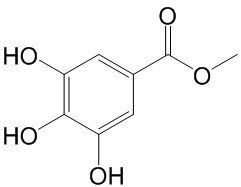Home
Products
Methyl gallate



| Product Name | Methyl gallate |
| Price: | $18 / 20mg |
| Catalog No.: | CN03745 |
| CAS No.: | 99-24-1 |
| Molecular Formula: | C8H8O5 |
| Molecular Weight: | 184.15 g/mol |
| Purity: | >=98% |
| Type of Compound: | Phenols |
| Physical Desc.: | Powder |
| Source: | The herbs of Sapium sebiferum. |
| Solvent: | Chloroform, Dichloromethane, Ethyl Acetate, DMSO, Acetone, etc. |
| SMILES: | COC(=O)c1cc(O)c(c(c1)O)O |
| Contact us | |
|---|---|
| First Name: | |
| Last Name: | |
| E-mail: | |
| Question: | |
| Description | Methyl gallate is a plant phenolic with antioxidant, anticancer, and anti-inflammatory activities. Methyl gallate also shows bacterial inhibition activity. |
| Target | Bacterial[1] |
| In Vitro | The growth of A. viscosus is inhibited completely by a low dose of Methyl gallate (MIC=1 mg/mL). S. mutans and . sobrinus show intermediate sensitivity to Methyl gallate (MIC=2-4 mg/mL), whereas the growth of Lactobacillus spp. is inhibited completely at a relatively high concentration (MIC=8 mg/mL)[1]. Methyl gallate, in a concentration of 100 mM, could alleviate lipid peroxidation of the cells exposed to a short-term H2O2 treatment. In addition, Methyl gallate-treated cells could prevent intracellular glutathione (GSH) from being depleted following an exposure of H2O2 (8.0 mM) for a 3 h period[2]. Methyl gallate inhibits Treg cell-suppressive effects on effector CD4+ T cells and Treg migration toward tumor environment. Furthermore, forkhead box P3 (Foxp3) expression is also significantly decreased by methyl gallate[3]. |
| Cell Assay | KB cells, a human mouth epithelial cell line, are treated with Methyl gallate (1-8 mg/mL) for 24 h. Cytotoxicity of Methyl gallate is assessed by a modified MTT assay[1]. |
| Density | 1.5±0.1 g/cm3 |
| Boiling Point | 450.1±40.0 °C at 760 mmHg |
| Flash Point | 190.8±20.8 °C |
| Exact Mass | 184.037170 |
| PSA | 86.99000 |
| LogP | 1.54 |
| Vapour Pressure | 0.0±1.1 mmHg at 25°C |
| Storage condition | 2-8°C |